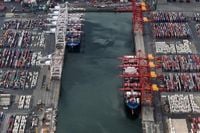Australia's economic landscape is facing a challenging outlook as the government anticipates a significant decline in its energy and mining exports. According to a recent report from the Ministry of Industry, the country expects a 6% drop in exports to approximately 387 billion Australian dollars by June 2025, down from 415 billion Australian dollars in the previous fiscal year.
This anticipated downturn is largely attributed to falling iron ore prices, a crucial commodity for Australia's economy. The report highlights that the exchange rate poses a considerable risk to the nation's basic goods exports, with expectations of a decline in the value of the US dollar impacting the pricing of imports and food.
High prices during the pandemic, adverse global conditions, and the repercussions of the Russian invasion of Ukraine had previously bolstered supply. However, the current forecast indicates that profit margins will likely witness more modest declines compared to the previous five years, stabilizing around 343 billion Australian dollars by the end of the forecast period.
Iron ore remains a cornerstone of Australia's export economy, despite predictions of declining prices due to a robust global supply and reduced demand from China. Notably, exports of iron ore to China from the Port of Hedland, a key indicator of industrial activity in China, fell by 14.8% in February.
Meanwhile, on the stock market front, Australian shares closed lower on March 31, 2025, with the S&P/ASX 200 index dropping by 1.74%. This decline was led by losses in the materials and resources sectors, reflecting the broader economic concerns tied to export forecasts.
Among the day’s notable performers, Orora Ltd saw its shares rise by 4.44%, closing at 1.88, while Omni Bridgeway Ltd and Wisetech Global Ltd also experienced gains of 3.64% and 1.47%, respectively. In contrast, companies like Zip Co Ltd and Pilbara Minerals Ltd faced significant declines, with shares dropping by 7.88% and 7.63%.
The S&P/ASX 200 VIX, which measures the implied volatility of options on the index, rose sharply by 27.42%, closing at 14.85, indicating increased market uncertainty. Additionally, gold futures for June delivery increased by 0.96%, reaching $3,144.22 per ounce, while WTI crude futures saw a modest rise of 0.39%, closing at $69.09 per barrel. However, Brent crude futures fell by 0.30%, ending at $72.54 per barrel.
Currency movements also reflected the day's trading dynamics, with the AUD/USD pair maintaining stability at 0.63, while the AUD/JPY pair experienced a decline of 0.52%, settling at 93.72. The dollar index also saw a slight increase of 0.18%, closing at 103.53.
As Australia navigates these economic challenges, the government's projections underscore the need for adaptation in the face of fluctuating global markets. The reliance on key exports like iron ore, coupled with the impacts of international events, will likely shape the economic landscape in the coming years.
In summary, Australia's export sector is bracing for a tough year ahead, with the anticipated decrease in energy and mining exports signaling broader economic implications. Investors and stakeholders will be closely monitoring these developments as they unfold.





